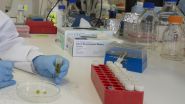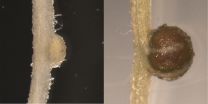Secondhand smoke increases stroke risk by 30 percent for nonsmokers
More evidence of harm, according to new study in the American Journal of Preventive Medicine
2015-07-09
(Press-News.org) Ann Arbor, MI, July 8, 2015 - Nearly 800,000 people in the U.S. suffer a stroke each year. Stroke is responsible for one out of every 19 deaths in the U.S. and it is a leading cause of disability. A new study published in the American Journal of Preventive Medicine found that secondhand smoke (SHS) increases the risk of stroke by about 30 percent for nonsmokers.
Using data from the Reasons for Geographic and Racial Differences in Stroke (REGARDS) study, a national, population-based, longitudinal study investigating cardiovascular disease events and mortality endpoints among white (55 percent) and African American (45 percent) adults aged greater than 45 years, investigators found that even after adjustment for other stroke factors such as hypertension, diabetes, and heart disease, the 30 percent risk for nonsmokers remained.
The current study included almost 22,000 participants (38 percent African American, 45 percent male) with 23 percent reporting SHS exposure in the past year. During the period of April 2003 to March 2012, 428 strokes were reported. A further analysis of the type of stroke (ischemic vs. hemorrhagic) was performed and showed that most strokes were due to blockage of blood flow to the brain (352 ischemic, 50 hemorrhagic, and 26 strokes of unknown subtype).
The literature concerning adverse health effects of SHS is becoming clearer, although not all studies have replicated the association between SHS exposure and stroke. According to lead author Angela M. Malek, PhD, of the Department of Public Health Sciences, Medical University of South Carolina, Charleston, "Previous studies suffer from limitations in that few were prospective, adjustment for potential confounders has varied, stroke and SHS exposure have not been consistently defined, measurement and sources of SHS exposure have differed, stroke subtypes have not always been assessed, and some studies have been underpowered due to small sample size."
The strengths of the current study result from the use of a population-based sample of a large, prospectively followed, well-characterized group of people that includes a large proportion of African Americans and physician-adjudicated incident strokes.
"Our findings suggest the possibility for adverse health outcomes such as stroke among nonsmokers exposed to SHS and add to the body of evidence supporting stricter smoking regulations. Future research will need to investigate the role of cardiovascular disease risk factors in the association and explore potential exposure to additional environmental variables, such as ambient air pollutants, in relation to stroke." explained Dr. Malek.
INFORMATION:
ELSE PRESS RELEASES FROM THIS DATE:
2015-07-09
New York, 9 July - Investing up to 3.5% of a nation's GDP in science, technology and innovation - including basic science and education - is a key benchmark for advancing sustainable development effectively, leading experts say.
In papers released July 9 in New York, international scientists advising UN Secretary-General Ban Ki-moon say closing the gap between developed and developing countries depends on first closing international science, technology and innovation (STI) investment gaps.
According to the UN SG's 26-member Scientific Advisory Board: "While a target ...
2015-07-09
Scientific journals should insist on more robust experimental processes, say biologists after reviewing nearly 900,000 experiments.
The team found that non-blind experiments - that is, where scientists knew which samples they were recording - averaged a 27 per cent stronger result than blind trials.
However their review suggests that less than one in four experiments used blind data recording.
"We found that non-blind papers tended to exaggerate differences between the experimental group and the control group," said lead researcher Dr Luke Holman, from the Research ...
2015-07-09
Long-time smokers and past smokers now have a more accurate way of detecting whether or not they have lung cancer thanks to a comprehensive lung cancer screening program that uses CT scan technology at Intermountain Medical Center in Salt Lake City.
The program is based on the findings of the National Lung Screening Trial, a study that compared CT scans and standard chest X-rays in detecting lung cancer. CT scans use X-rays to obtain a multiple-image scan of the entire chest, while a standard chest X-ray produces a single image of the whole chest.
Results from the study ...
2015-07-09
An international team of researchers has discovered how legumes are able to tell helpful and harmful invading bacteria apart. The research has implications for improving the understanding of how other plants, animals and humans interact with bacteria in their environment and defend themselves against hostile infections. These findings can have profound implications for both agricultural research and medical science.
Their study, which changes the understanding of carbohydrates as signal molecules, is newly published in the leading international journal Nature.
Legumes ...
2015-07-09
ORLANDO, FL - An athlete's use of silicone ankle sleeves (SAS) and lace-up ankle braces (LAB) during sports participation can improve neuromuscular control, according to research presented today at the American Orthopaedic Society for Sports Medicine's (AOSSM) Annual Meeting in Orlando, FL.
"Athletes often use prophylactic sleeves or braces, and this study used markerless motion analysis to determine whether these support aids are beneficial," said lead author Seth L. Sherman, MD, from the University of Missouri - Columbia Department of Orthopaedic Surgery.
The study ...
2015-07-09
ORLANDO, FL - Surgeons making reconstruction choices for an injured ACL can consider both bone-tendon-bone grafts and hamstring autografts as equally viable options in regards to healing, as reported in research today at the American Orthopaedic Society for Sports Medicine's (AOSSM) Annual Meeting in Orlando, FL.
"We compared the graft-tunnel motion of patients receiving either kind of graft, and noted both groups had similar graft motion at six weeks and one year from surgery, both ranged between 1-2 mm," commented Justin W. Arner, MD, from the University of Pittsburgh ...
2015-07-09
A new study by UCLA scientists adds to the understanding of the genetic architecture of schizophrenia.
Past research has shown the impact of commonly occurring genetic variants on a person's risk of developing schizophrenia. This new study focused instead on rare coding mutations that affect protein function. It found that patients with schizophrenia have a higher-than-normal share of these mutations.
"While we cannot point to specific mutations that play a causal role in schizophrenia, we show that schizophrenia patients collectively have more of these mutations than ...
2015-07-09
More than a third of overweight or obese teenagers don't see themselves as being too heavy and think their weight is about right, according to a Cancer Research UK study published today in the International Journal of Obesity.
The study* used data from around 5,000 13-15-year-olds who were asked about their weight and if they thought they were too heavy, about right or too light.
Researchers then checked their answers against their Body Mass Index (BMI)** -- to see whether the reality matched the teenagers' perceptions of themselves.
Almost three-quarters (73 per ...
2015-07-09
Public attitudes towards mental illness and levels of healthcare spending may explain the huge variation in antidepressant use across Europe, according to a new study by researchers from the Institute of Psychiatry, Psychology & Neuroscience (IoPPN) at King's College London.
The study, published today in the British Journal of Psychiatry, found that antidepressants were prescribed more often and used more regularly in countries with higher levels of healthcare spending. In addition, beliefs that people with a mental illness are 'dangerous' were associated with higher ...
2015-07-09
The UK government's investments in private hospital chains in developing countries, in the form of 'beyond aid' approaches, could actually be hindering inclusive development and need greater scrutiny, argue experts in The BMJ this week.
'Beyond aid' policies aim to address underlying causes of poverty, and focus on the use of loans and equity investments to support the growth of private companies. As part of this strategy, tens of millions of pounds have been committed by the Department for International Development's investment arm, CDC Group, to private hospitals and ...
LAST 30 PRESS RELEASES:
[Press-News.org] Secondhand smoke increases stroke risk by 30 percent for nonsmokers
More evidence of harm, according to new study in the American Journal of Preventive Medicine

